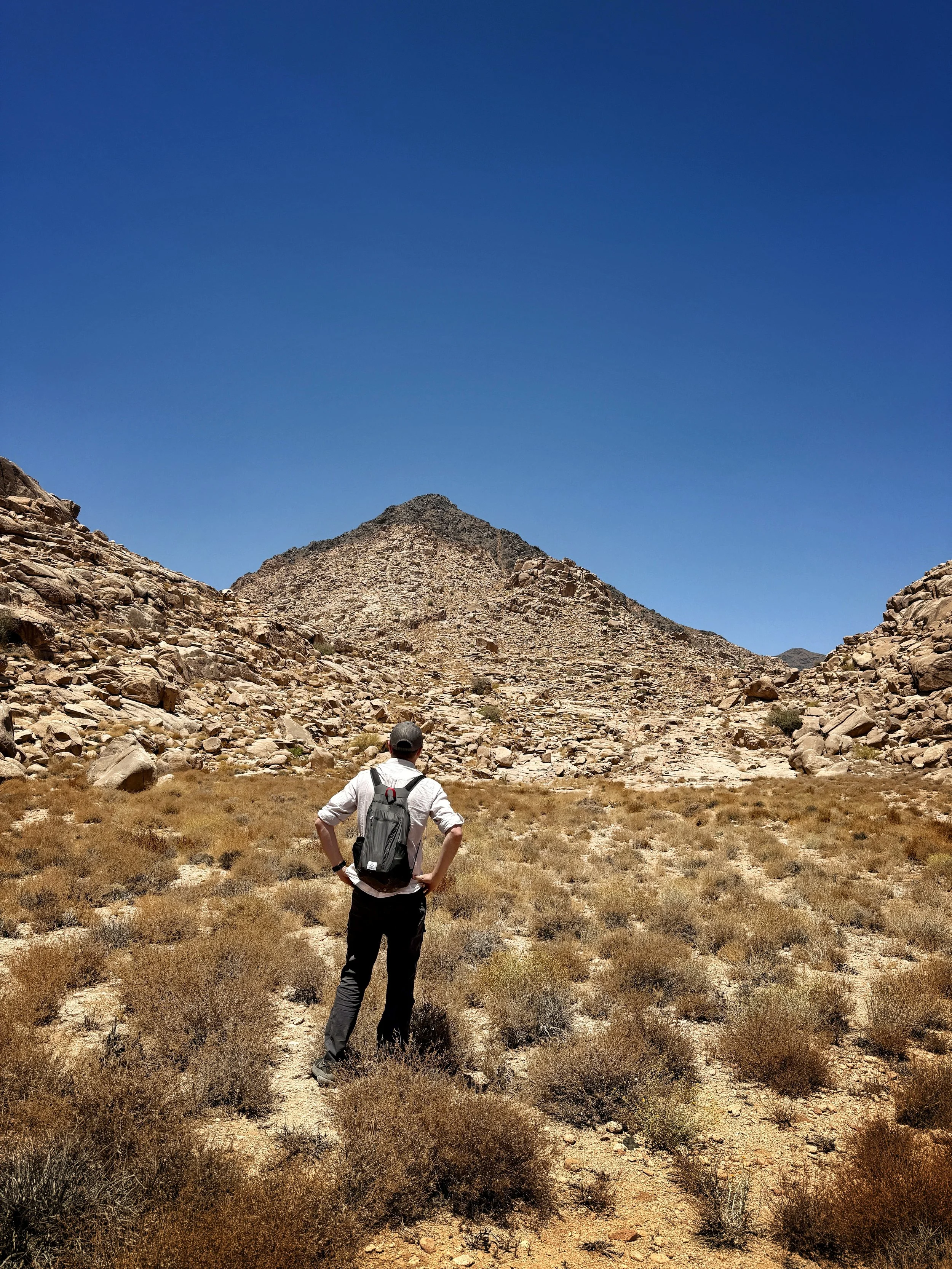It IS God’s will to Heal You: Often times, believers will question whether it is truly God’s will to heal. Sometimes Christians will say in times of distress or affliction, “Who knows what the will of God is? Perhaps this sickness is His plan for a greater good?” or they will proclaim without knowledge that, “God’s will is mysterious and indiscernible” or furthermore pray in unbelief saying, “Lord, if it’s Your will, heal me.” Simply stated, those types of comments are unbelief and the opposite of what the Bible says. Healing is part of God’s redemptive plan.
The God Type of Heart: Part Two - Moses
Part Two: Moses — Moses grew up in a time where his people, the Hebrews, were oppressed by the Egyptians. His life was suppose to end at birth. The Egyptians, who feared the rise of the enslaved Hebrews sent an edict throughout the land that all newborn male Hebrews were to be thrown into the Nile and drowned. Moses, whose mother couldn't bare this outcome, set him in the reeds of the Nile hoping life would find him.
The God Type of Heart: Part One - David
July '09 Newsletter
Dear Friends,
Greetings in the Lord! This month we would like to continue with Part 2 of our Uncontacted Expedition AMAZON. We want to thank you for your prayers and support. We can truly feel them as we venture to these remote lands and are so grateful for your love and commitment.
Uncontacted Expedition AMAZON Part Two: We enter the jungle. The triple canopy has a cool breath as we walk into its shadows. Somewhere in this green world is a tribe that has never made contact with the outside. Our investigation has led us to this specific area and now we must walk deeper, hoping to make peaceful contact.
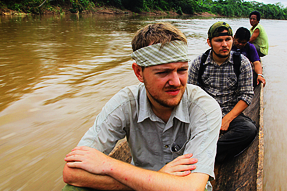
Day 1 Jungle: (After investigations and interviews in surrounding villages.) No rain today. Food provisions doing okay. One can of tuna a piece for 8-hours hiking. Can’t take any extra weight. Having to conserve water as well for hike back. First destination—creek bed where multiply sighting happened within the last 15 days. Bushmen Pepe and Felix lead the way. Their machetes clear the twisted vines. We cross a creek and see a Coral snake glide through the water. Highly poisonous and if we take a bite this far in—it is over, unless we shake it off like the Apostle Paul. Someone back home is praying for us so we tiptoe over the log with confidence. We hike and hike until we reach a small creek. We hear whistling and bird noises all around us. Pepe and Felix are spooked. Monkeys chime in as well. Then silence. We look at the creek bed and notice footprints. Felix almost destroys it by accidentally stepping on it, but pictured on the right side of photograph next to the large boot print there is an outline of a small child’s footprint. This is our first sign. Everyone is excited. We mark it on GPS.
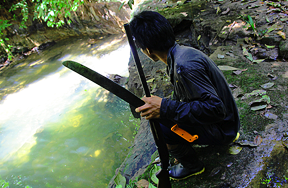
Day 2 Jungle: We hike on an alternate path. This is the location where four uncontacted tribe men were spotted fishing with spears. We round a ridge and hear the bush rustle. We come down to the creek bed. Large prints, not human, but that of a Leopard. It is a big one too. Fresh it must have just been here. Pepe and Felix, say this area is very dangerous because these animals don’t come into a lot of contact with humans and might consider us prey. We pray to not be prey. Pepe shows us the sight and takes us to the place where he says he saw more foot prints 5 days before we arrived. Nothing there anymore. Footprints, if found are always fresh, because the rains will cover them each night and erase evidence. We hike back to camp. Will takes a nasty fall into a branch of thorns. Picks them out with his head light at camp that night. Doesn’t get one the stickers out until two weeks later.
Day 4-6 Jungle: Food provisions getting lower. Still on the one can tuna diet. Hiking everyday. Muscles used to jungle now. When we march it just feels like a trance. We come to a beautiful lagoon and rest for a moment. 20-meters further on, as we hike up the riverbed, we notice a fresh human print in the water. They are close? Probably watching us. They are people of the jungle, they know how to disappear, and they know how to observe. We hear more noises, and then head back to camp.
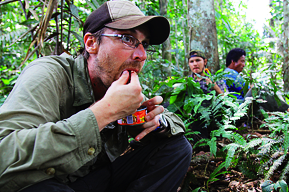
Day 7 Jungle: Getting to our furthest points in the jungle. Leaving a gift hung in the trees. A metal pot, plastic cup (both items they would recognize as similar to their crude instruments), and a pictorial of us and them greeting each other. Pictures are the only language we can both understand (we drew the pictorial based on the tribe’s description). We leave the gift. We take a hunting trip on the main river at night for meat. No motor just paddles. The darkness and quite is overwhelming and peaceful. 1-hour later a violent downpour of rain breaks the serenity. We spend the next terrifying 5-hours bailing water making our way back to camp. Water comes within a half inch to totally submerging canoe and drowning.
Day 8 Camp: Although we do not make contact we are all positive of the tribe’s existence and their territorial range. The unusually high water volume and unseasonal rains would make the best opportunity for contact in late August or September this year. At the village camp we minister at church and pray for the sick. Members are excited that we have done this mission, as many are fearful to undertake contact.
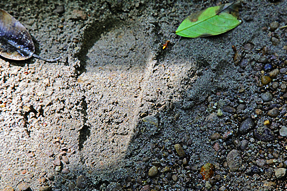
Day 10 Camp: They are out there. Close. We pray we will be able to return and make peaceful contact. We pray the Holy Spirit will guide this tribe and prepare their hearts. We pray for those who have not heard the gospel.
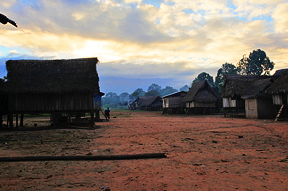
To step out and attempt what no one has attempted before we must give our all. How can our conscience be clear if we have the ability to reach someone and fail because of fear or discomfort? You get one pass at life. Life it to the fullest for Him. Let not fear rule you, but live in such a way to accomplish the mission you were sent for. Step out in boldness and don’t worry about the results. God works by faith, not by sight.
Our mission is to accomplish Mark 16:15 and with your prayers and support you are with us as we bring the gospel to all creation. Together we are accomplishing much! But without your help we cannot do any of this. It is your continued support that opens doors and prepares the way. Please consider supporting our upcoming missions and current expeditions (Anti-Narcotics Colombia, Island Revival campaigns, uncontacted journeys.) You are in our hearts always and we need your help to go further and reach more. Peace be with you!
In Him, Tim and Will
June 2009 Newsletter
Dear Friends, Greetings in the Lord. As we emerge from the remote jungles of the Amazon basin we are encouraged by your support, in prayers and finances, as we attempt to reach those who have never been reached before.
Uncontacted Expedition AMAZON Part One: Matthew 24:14 “And this gospel of the kingdom shall be preached in the whole world for a witness to all nations, and then the end shall come.” Today we stand on the precipice of accomplishing the great commission. The last frontier is that of the undiscovered and uncontacted. Imagine there are people on earth who have no contact with the outside world and no knowledge of the good news. This is our mission.

On May 30th, 2008, images of an uncontacted tribe hit the mainstream media with shock and awe. They displayed red and black painted figures pointing arrows at the hovering aircraft above. This tribe had never made contact with the outside world. As soon as we saw this we began our preparations to reach tribes just like that one.
Almost one-year later we bumped our way over the twisted jungles in a small floatplane. Our destination—a remote Amazon tributary. Our mission—first contact. This wasn’t just first contact for the gospel, but first contact for anything. The tribe we were attempting to reach was much like the ones pictured in the spectacular photos, but living in a different area.
First contact is much more difficult than one might think. There is no known language, other than commonalities of root tribal dialects, there is no assurance of peaceful contact, and there is no knowledge that this tribe wants to be contacted. Questions, and important ones at that, but all the answers were in the jungle.

Landing on the shores of a muddy river we set up camp at a small village that would be our headquarters. Our expedition party was 7-members and thousands of prayer warriors (You!). The team on the ground was two local Bushmen from the village, two bush pastors, one translator, and the two of us. Immediately we set ourselves to interviewing locals at this small village and piecing together where we might make contact. The rivers and tributaries of the Amazon basin were now receding, as dry season approached, and this was the time of year in the past that most sightings occurred.
First, we wanted to gather the most accurate information and interview as many people in various villages as possible. In our interviews, two stories stood out the most to us. The first was of an older man, who recently while hunting a bird deep in the jungle noticed something as he aimed his gun towards the treetops. Sensing a presence he looked over and saw two males from this uncontacted tribe hunting the same bird. They approached him in a friendly manner and started to speak. He said he could not understand them, but will never forget what they looked like. He said they were naked, save a small string tied around their waste, holding up their male member. They had long hair, and strangely, beard hair that grew long below their jaw line. He ran away in fear and didn’t stop running until he reached the river 5 KM from his village. The second story occurred only 15 days ago and was told to us from the brother of one of the pastors on our team. He said he was hunting in the jungle 6-hours from our current location, and upon coming over a small hill in the jungle, he looked down to see four males from this mysterious tribe fishing in a stream with spears. He watched them for a minute and then ran away. They were close, and in the area, but nomadic, so it was important for us to head into the jungle right away.

The existence of this uncontacted tribe had been confirmed by more than just the villagers living in the area, but by anthropologists and the scientific community as well. We interviewed dozens of eyewitnesses and used resources from our previous research to pin point locations on the GPS where the tribe had been spotted the most. In rare circumstances the tribe had even been seen on the shore of the large river collecting turtle eggs. We were ready to head into the jungle and start our search.
All the stories of brief contact with the villagers led us to believe this tribe was just as curious of outsiders as we were of them. The evidence also suggested they had tried to make contact in the past, but were fearful. Both peoples seemed to be afraid of each other, setting up an uneasy feeling between each tribe. At first, before we even arrived in the village, we had heard only negative stories about this uncontacted tribe’s behavior, and even threatening stories about violent encounters, but after our interviews we concluded that this was not the case. Eyewitness reports confirmed their described behavior was more curious than threatening.
For contact, before we entered the jungle, we left it up to the Lord. Perhaps they do not want to be contacted? We cannot force contact or in the same right presume they do not want to have any. God made himself evident to all mankind through his creation (Romans 1:19-20). Our mission was to give this tribe the choice to make peaceful contact with us.

So we set off into the harsh jungles and readied ourselves for whatever we might face… Part Two coming next month.
With your help in prayers and finances we are able to conduct gospel expeditions like the uncontacted journey. Your help is needed more than ever as we attempt to bring the gospel where it has never gone before. Our mission is not only to speak the good news, but also to carry that message to all mankind. Together we can do this and finally fulfill Matt. 24:14! Let us reach beyond ourselves and touch the unknown with the life saving message of Christ Jesus! Please consider supporting us through a one-time gift or monthly support. Our next missions include: Anti-Narcotics missions in Colombia, first contacts, and island revival campaigns. You are family to us and your support is treasured and needed. Peace be with you.
In Him, Tim and Will
May '09 Newsletter
Dear Friends, Greetings in the Lord. We want to thank you for your prayers over the last month, as they have opened the door for the gospel in an area that has been held in darkness. It is with your help that we tread new paths and deliver the message of hope, so please continue in every way.
This month we would like to share about our time in Potosi, Bolivia. Potosi is a high altitude town (13,500 feet) in the southern regions of Bolivia. At first glance, when one arrives, you would think it was just like any other Bolivian town, but Potosi has a history that literally shaped the course of the world.
In 1546, the city of Potosi was founded, and by the end of the 16th century it was the richest city in the world! How, one might ask? —Silver. There is one distinctive geographical feature that separates Potosi from any other city, and that is the towering mountain that sits above it called Cerro Rico (Rich Mountain). The mountain of Cerro Rico was the richest silver mine in the world from 1560-1800. It was the breadbasket of the Spanish Empire and where the majority of the Spanish wealth was derived. Ever wonder where Spain got their money to build the mighty Spanish Armada? Answer—Cerro Rico.
By 1672, a mint was established, in Potosi, to coin silver and water reservoirs were built to fulfill the growing population's needs. At that time, more than eighty-six churches were built and the city's population increased to nearly 200,000, making it one of the largest and wealthiest cities in Latin America and in the world. At that time, Potosi had a larger population than Paris, Madrid, or London.
Unfortunately, such wealth came at extreme costs. Over eight million people were killed by forced labor in the mines and the religious manipulation of the Spanish Catholic Church caused effects that still keep the people of Potosi in darkness.
Now jump ahead to Potosi 2009. Arriving in the city of Potosi you immediately see the view of defunct colonial churches and the towering sight of Cerro Rico. The mines are still worked today, mostly by locals who brave the deep tunnels to extract silver by hand. Our mission was to minister to the miners of Cerro Rico and bring the gospel to Potosi. There are no foreign missionaries working in Potosi and the spiritual climate is very dark.

One story we heard, before we entered the mines, was the active worship of the devil inside Cerro Rico. The history behind this was shocking. It all started when the Spanish felt it necessary to motivate the slaves that worked the mountain. So, Spanish authorities created a god that the slaves could worship inside the mines. Also, because they deemed slaves less than human, standard Catholic Christ and Mary worship weren’t a consideration. The Spanish thought the slaves (many of them darker skinned Africans and local Indians) were sons of the devil, so they ought to worship Satan, as they were already damned to hell anyways. The Spanish told the miners these demon idols were God. In the Spanish language God is called Dios, but the local Indians couldn’t pronounce the letter D so they quickly called the idols Tio. Or El Tio, which means, The Uncle in Spanish. When we traveled deep inside the mines we came across the Tio idols and witnessed the miners who still worship them as God. We saw Tio idols dating as far back as the 16th century. So with all that back-story our mission was set to bring the truth.
Five separate days we moved deep inside the mines sometimes traveling as far as 4km and crawling through openings only 18-inches. The gases, silica and asbestos caused us to cough uncontrollably at times, and certain mine shafts that we entered were over 100 degrees in temperature. The detonations of dynamite kept us all on edge and it wasn’t hard to see why most miners only last 10-15 years in these conditions. But the biggest killer inside the mines isn’t explosions or tunnel collapses, but lung disease and toxic fumes.

As we traveled deeper and deeper every day we delivered gospel tracks and small $2 solar powered radios tuned to a Bolivian gospel radio station to each miner we came across. We also talked with miners in small groups as they chipped away at the rock. One man we talked to was killed 6-days later when toxic gases overcame him in the very area we chatted. This might have been the only chance for him to hear the gospel. Outside the mines we also ministered to women who sorted through the rubble looking for discarded minerals (women are not allowed to work inside the mine because it is considered back luck). In one circumstance we ministered to two elderly ladies. One of the ladies was 81-years old and had worked outside of the mines picking through rocks for 50 years. She told us she made .20 - .50 cents a day for her work. We prayed and shared the word with them and they were grateful to hear the gospel. They were also thankful to receive the small gospel radios and turned them on right away.
In our travels to Bolivia we found an area with a rich and dark history that once was the center of the world. But today this area has been forgotten. We need more laborers to be sent into the harvest. If a city like Potosi, which was once the largest and richest in the world, could be forgotten, no city in the world is safe. We must speak the message and be bold to take the gospel everywhere.
Your prayers and support have enabled us to reach places like Potosi and establish the beginnings of something great with the local ministries in Bolivia. We will need your support more than ever as our next mission will bring us to an uncontacted tribe in Peru. The journey will be long and difficult, but with your prayers, a hedge of protection is around us and with your giving we have the means to make such journeys. Please consider supporting Travel the Road through a one-time gift or monthly donation. Your support is critical and we need it more than ever, as together we attempt to complete the great commission.
In Him,
Tim and Will

